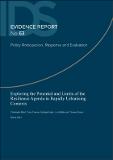| dc.contributor.author | Béné, Christophe | |
| dc.contributor.author | Cannon, Terry | |
| dc.contributor.author | Gupte, Jaideep | |
| dc.contributor.author | Mehta, Lyla | |
| dc.contributor.author | Tanner, Thomas | |
| dc.coverage.spatial | India | en_GB |
| dc.coverage.spatial | Bangladesh | en_GB |
| dc.date.accessioned | 2014-03-19T16:21:11Z | |
| dc.date.available | 2014-03-19T16:21:11Z | |
| dc.date.issued | 2014-03 | |
| dc.identifier.citation | Béné, C.; Cannon, T.; Gupte, J.; Mehta, L. and Tanner, T. (2014) Exploring the Potential and Limits of the Resilience Agenda in Rapidly Urbanising Contexts, IDS Evidence Report 63, Brighton: IDS | en_GB |
| dc.identifier.uri | https://opendocs.ids.ac.uk/opendocs/handle/20.500.12413/3621 | |
| dc.description.abstract | More than half the world’s population now live in urban areas. In developing countries, these areas will become home to almost all of the projected 50 per cent population growth that will occur between now and 2030, swelling urban populations by a further 1.3 billion by 2030 and 2.5 billion by 2050 (GMR 2013). As a result, by the middle of the century, urban dwellers will account for more than 85 per cent of the population in the more developed countries and more than 65 per cent in the less developed regions. Overall, it is expected that seven out of ten people will be living in urban areas by 2050 (UN-Habitat 2011).
In this rapidly changing environment, megacities, urban corridors and city regions have attracted the largest attention of both academics and policymakers. In comparison, far less is known about smaller and emergent urban areas (Ferre, Ferreira and Lanjouw 2011), even if most of the current urban population in the world live in small and medium towns (WUP 2012) and the major part of population growth is projected to take place in those towns under one million people (using 2005 UN population estimates).
As part of the Tomorrow-Today Horizon Scanning Initiative supported by IDS, the project ‘Exploring the Potential and Limits of the Resilience Agenda in Rapidly Urbanising Contexts’ aims to analyse the emergence of the concept of ‘urban resilience’ in the literature and to assess the potential and limitations of this concept as an element of policy narrative, especially in the context of rapid urbanisation processes. In order to give a more empirical dimension to this analysis, we also included two case studies (one large city – Mumbai in India, and one smaller city – Khulna in Bangladesh) with the aim of relying on these case studies to better understand some of the crucial processes characterising urbanisation, to scrutinise the dynamic and evolving linkages and processes that connect the rural and the urban in the peri-urban interface and the ways in which resources are differently defined, appropriated and used by various interest groups. | en_GB |
| dc.description.sponsorship | UK Department for International Development | en_GB |
| dc.language.iso | en | en_GB |
| dc.publisher | IDS | en_GB |
| dc.relation.ispartofseries | IDS Evidence Report;63 | |
| dc.rights.uri | http://creativecommons.org/licenses/by/3.0/ | en_GB |
| dc.subject | Climate Change | en_GB |
| dc.subject | Politics and Power | en_GB |
| dc.subject | Population | en_GB |
| dc.title | Exploring the Potential and Limits of the Resilience Agenda in Rapidly Urbanising Contexts | en_GB |
| dc.type | IDS Evidence Report | en_GB |
| dc.rights.holder | IDS | en_GB |
| dc.identifier.ag | OT/11009/7/1/1/249 | |


